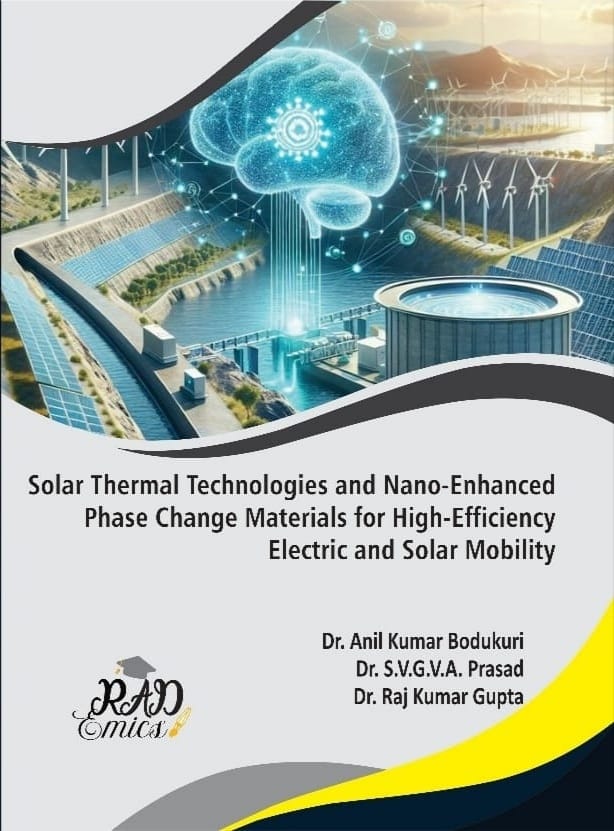
Solar Thermal Technologies and Nano-Enhanced Phase Change Materials for High-Efficiency Electric and Solar Mobility
Dr. Anil Kumar Bodukuri, Dr. S.V.G.V.A. Prasad, Dr. Raj Kumar Gupta
Indexed In: Google Scholar
Release Date: 27/06/2025 | Copyright:©2025 | Pages: 390
DOI: 10.71443/9789349552654
ISBN10: 9349552655 | ISBN13: 9789349552654
This work explores advanced solar thermal technologies integrated with nano-enhanced phase change materials (NEPCMs) to improve energy efficiency in electric and solar mobility systems. NEPCMs offer superior thermal conductivity and energy storage capacity, enabling effective heat management and load leveling in vehicles. By harnessing solar energy and optimizing thermal storage, the approach supports sustainable transportation, reduces battery load, and enhances vehicle range. The study highlights innovative system designs, material selection, and integration strategies that address thermal challenges in mobile applications. This convergence of solar thermal energy and nanotechnology presents a promising pathway toward high-efficiency, low-emission mobility solutions.
This book offers an in-depth exploration of solar thermal technologies aimed at enhancing the performance and efficiency of electric and solar mobility systems. It covers the fundamental principles of solar energy harvesting, thermal energy conversion, and storage techniques tailored for transportation applications. Emphasis is placed on system design, thermal management, and integration strategies to optimize energy use in electric vehicles and solar-powered transport infrastructure. Through case studies and practical insights, the book highlights the potential of solar thermal solutions in reducing fossil fuel dependency and promoting sustainable mobility. It serves as a vital resource for engineers, researchers, and energy innovators.
Dr. S.V.G.V.A. Prasad is an accomplished physicist and educator with extensive experience in academia and research. He currently serves as a Professor of Physics at Pithapur Rajah's Government College (Autonomous) in Kakinada, Andhra Pradesh, India. Dr. Prasad completed his M.Sc. from Andhra University in 1994. He went on to earn his M.Phil. from Acharya Nagarjuna University in 2002 and his Ph.D. from the same institution in 2007. Professor of Physics at Pithapur Rajah's Government College (Autonomous) since September 2021.Senior Lecturer in Physics at Ideal College of Arts and Sciences, Kakinada from May 2013 to August 2021. Dr. Prasad specializes in materials science, with a focus on glasses and ceramics. His research areas include: Synthesis and characterization of glasses and glass ceramics, Dielectric properties of materials, Spectroscopic studies of doped glasses, Nonlinear optical properties of glasses. Published number of research papers in various journals. Presented at 59 conferences, including international and national events. Filed patents related to materials science and technology. Dr. Prasad is actively involved in the academic community and holds memberships in several professional organizations related to physics and materials science. With over a two decades of teaching experience, Dr. Prasad has taught various courses in physics at the undergraduate and postgraduate levels. He has also guided several research projects for M.Phil. and Ph.D. students. S.V.G.V.A. Prasad's contributions to physics education and materials science research have established him as a respected figure in his field, making him a valuable asset to the academic community.
Dr. Raj Kumar Gupta is currently an Senior Assistant Professor, Sardar Vallabhbhai Patel College, Bhabhua, Constituent unit of Veer Kunwar Singh University, Ara, Bihar. He completed his Ph. D. from University of Delhi, delhi.His area of interest is Material Science & Computing, IoT. He has 10 years of experience in teaching and research. He is a Life Member of STAMI. He has co-authored & published patent, copyright, also participated in national & international conferences like AICTE, ISTE approved-sponsored, IEEE and published research papers in renowned international journals including Scopus indexed. He has participated in AICTE, and university sponsored FDP & workshops including material Science, AI related studies. He has been worked as a Reviewer of research papers in Conference. He has delivered Expert Talks various seminars.
Dr. Anil Kumar Bodukuri working as an Assistant Professor (C) in the Department of Mechanical Engineering at Kakatiya University College of Engineering and Technology, Kakatiya University Warangal. He graduated in Engineering at Jatipita College of Engineering (affiliated to JNTUH), Adilabad, Telangana, India. He secured Master of Engineering in Department of Mechanical Engineering at National Institute of Technology Warangal (NITW), Warangal, Telangana, India. He is awarded Ph.D., in Department of Mechanical Engineering at Kakatiya University, Warangal, Telangana, India. He is in teaching profession for more than 13 years. He has Published 20 papers in National and International Journals, Conference and Symposiums. His main area of interest includes Manufacturing technology, Design Engineering, Composite Materials and Renewable Energy Sources.